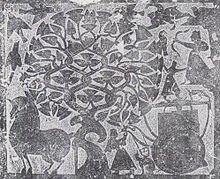Fusang

Fusang (Chinese: 扶桑; pinyin: Fú Sāng) is the name of a mythical place or a mulberry[1] tree in ancient Chinese literature. It is said to be east of China.[2]
A monk named Hui Shen (Chinese: 慧深; pinyin: Huì Shēn) was said to have visited Fusang. His description is written in the Book of Liang. Many people debated where Fusang is. Some say it is in the Americas, the Kamchatka Peninsula, or the Kuril Islands. After the First World War, most people no longer believe that it is in America.[1]
References[change | change source]
- ↑ 1.0 1.1 Joseph Needham; Ling Wang; Gwei-Djen (1971). "Pt. 3, Civil engineering and nautics". Science and civilisation in China. Vol. 4, Physics and physical technology. Cambridge University Press. pp. 540–542. ISBN 978-0-521-07060-7.
- ↑ Joseph Needham (1976). "Part 3, Spagyrical discovery and invention : historical survey, from cinnabar elixirs to synthetic insulin". Science and civilisation in China. Vol. 5 : Chemistry and chemical technology. Cambridge University Press. p. 19. ISBN 978-0-521-21028-7.
